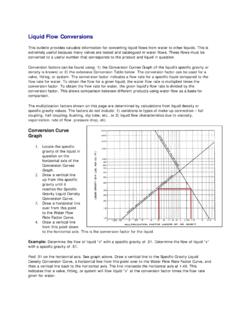Transcription of THERMOPHYSICAL PROPERTIES OF BRINES - mrc …
1 THERMOPHYSICAL PROPERTIESOFBRINESM odelsM. CONDE ENGINEERING, 2011 M. Conde Engineering, Zurich 2011M. CONDE ENGINEERING 2011 PROPERTIES of Working Fluids - BRINES 1 / 10 Secondary Fluids - BrinesSecondary refrigerants ( BRINES ) are used in refrigeration, air conditioning and heating plants wheneverindirect heat transfer processes take place, particularly when the risk of freezing must be considered. Thereare a large number of products on the market, some to be used in aqueous solutions, some entirely withoutwater. None represents a universal solution, and most present specific problems that must be properlyaddressed, in particular to avoid corrosion of pipes and THERMOPHYSICAL PROPERTIES of the BRINES influence the energy transport processes and so affectthe performance of plants and equipment. Thus, in the design and performance estimation of components,equipment and plants these external influences should be considered.
2 For this purpose, mathematicalmodels describing the THERMOPHYSICAL PROPERTIES of BRINES were developed and are described in BRINES considered here are aqueous solutions of ETHYLENE glycol and of PROPYLENEGLYCOL, which happen to be two of the most common in refrigeration, heat pump, air conditioning andsolar thermal applications. Before describing the models, a special mention of atmospheric air as a secondary fluid is to its particular PROPERTIES and availability, air is only second to water as a secondary fluid. Due to thepresence of condensable water vapour, a dedicated mathematical model is necessary for humid air. Thismodel is described in detail in other documents on this model of the THERMOPHYSICAL PROPERTIES of aqueous solutions ofETHYLENE glycol and propylene GLYCOLThe PROPERTIES necessary in the calculation of the heat transfer processes and piping circuits include- Density- Specific thermal capacity- Thermal conductivity- Viscosity- Prandtl number- Coefficient of thermal expansionand their variations with the operating conditions.
3 Besides these, the freezing temperature and theupper limit of use are also required for a complete description and identification of application limits duringsimulations. This limit may as well represent the limitations of the data available. Furthermore, thecoefficient of thermal expansion, , is also required in order to size the expansion vessel in closed / 10 PROPERTIES of Working Fluids - BrinesM. CONDE ENGINEERING 2011 Freezing TemperatureThe temperature of freezing depends upon the concentration of the solution, and may be determinedby an equation of the formDensity, Thermal Conductivity and Specific Thermal CapacityThe density, thermal conductivity and specific thermal capacity may all be calculated by the same kindof equation. The property is here represented by PxDynamic Viscosity and Prandtl NumberThe same applies to the calculation of the dynamic viscosity and Prandtl Number, with a slightlydifferent equationThese equations apply as well to pure water at the limit of null of Thermal ExpansionSince most applications of BRINES involve small to moderate temperature variations, it is necessaryto provide some expansion volume (expansion vessel) to absorb the expansion and contraction of the brinevolume due to these temperature oscillations.
4 In order to estimate the volume required for the expansionvessel it is necessary to know the coefficient of thermal expansion, , of the brine. This is defined asThe derivative is obtained from the equation for CONDE ENGINEERING 2011 PROPERTIES of Working Fluids - BRINES 3 / 10 Fig. 1 - Density of aqueous Ethylene GLYCOLP arameterOrder [kg/m3]Cp[kJ/kg K] [W/m K] [Pa s]Pr[-]TF[K] 00 Table I - Parameters of the mathematical models of aqueous solutions of ETHYLENE following figures depict charts of the THERMOPHYSICAL PROPERTIES of aqueous solutions ofETHYLENE / 10 PROPERTIES of Working Fluids - BrinesM. CONDE ENGINEERING 2011 Fig. 2 - Specific thermal capacity of aqueous Ethylene 3 - Thermal conductivity of aqueous Ethylene CONDE ENGINEERING 2011 PROPERTIES of Working Fluids - BRINES 5 / 10 Fig.
5 4 - Dynamic viscosity of aqueous Ethylene 5 - Prandtl Number of aqueous Ethylene / 10 PROPERTIES of Working Fluids - BrinesM. CONDE ENGINEERING 2011 Fig. 6 - Coefficient of thermal expansion of aqueous Ethylene CONDE ENGINEERING 2011 PROPERTIES of Working Fluids - BRINES 7 / 10 Fig. 7 - Density of aqueous Polypropylene GLYCOLP arameterOrder [kg/m3]Cp[kJ/kg K] [W/m K] [Pa s]Pr[-]TF[K] 35 Table II - Parameters of the mathematical models of aqueous solutions of / 10 PROPERTIES of Working Fluids - BrinesM. CONDE ENGINEERING 2011 Fig. 8 - Specific thermal capacity of aqueous Polypropylene 9 - Thermal conductivity of aqueous Polypropylene CONDE ENGINEERING 2011 PROPERTIES of Working Fluids - BRINES 9 / 10 Fig. 10 - Dynamic viscosity of aqueous Polypropylene 11 - Prandtl number of aqueous Polypropylene / 10 PROPERTIES of Working Fluids - BrinesM.
6 CONDE ENGINEERING 2011 Fig. 12 - Coefficient of thermal expansion of Polypropylene is the mass fraction of the glycol in solutionTis the absolute temperature in 2001. Handbook of Fundamentals, Chap. , ., E. Granryd 1992. Secondary Refrigerants for Heat Pumps and Low Temperaturerefrigeration A comparison of thermodynamic PROPERTIES of aqueous solutions andnon-aqueous liquids, Dept. of Applied Thermodynamics and Refrigeration, The Royal Instituteof Technology, Stockholm, 1991. W rmeatlas, 6. Auflage, VDI Chemicals Co., 1997. Ambitrol product information.





